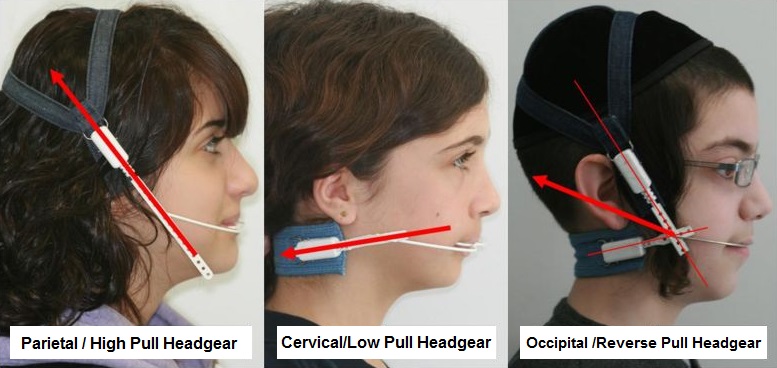Dentists use different Orthodontic headgear types with braces to correct severe malocclusion (or bite). The most commonly used Orthodontic headgear types are High Pull headgear, Reverse Pull headgear and Cervical headgear.
These Orthodontic headgear types are clinically used by orthodontist to correct the alignment of the upper jaw position and the lower jaw position. All Orthodontic headgear types aids to rectify the problems in the growth of the facial structures, by straitening the position and misalignment of the teeth and jaws.
These Orthodontic headgear types of headgear are typically used to correct an excessive horizontal overbite (overjet) in children. They hold back the growth of the one jaw to align it with the other. These Orthodontic headgears can also be used for adults with problems maintaining a proper bite. They are also used to correct tooth spacing after tooth extraction.
Patients with a high mandibular plane angle or long anterior face height will not benefit from this appliance as it has a tendency to increase lower face height. It is also not recommended to use a headgear for patients with overjet exceeding 9mm. In cases where molars are severely rotated, it is better to correct the rotation first before using a headgear.
Your dentist will decide and prescribe High Pull headgear, Reverse Pull headgear or Cervical headgear which one of these Orthodontic headgear types is most suitable in your case:
Orthodontic Headgear Types: High Pull, Cervical, Reverse Pull
Orthodontists decides headgear for braces based on the facial type and direction of growth. For example, patients with dolichocephalic facial type with excessive vertical growth tendency, will be prescribed Parietal/High Pull Headgear type as the direction of the pull should be upward. Let’s have a look at these Orthodontic headgear types one by one in the following:
-
Parietal/High Pull Headgear Type
The high Pull Headgear is connected to the back of the teeth through the braces. Unlike other Orthodontic headgear types, it is usually worn on the top of the head through a strap which is connected to the braces. High pull headgear for braces, helps in the alignment of the upper jaw by reducing the act of overbite.
-
Cervical/Low Pull Headgear Type
Just like the high pull headgear, this type of the headgear for braces, is preferred the most by the orthodontists. The Cervical pull type has U-shaped wire which is connected with the braces at the back of the molars. The wire is then attached with the band which is connected with the headgear. This Cervical Pull headgear for braces is worn on the back of the neck and is used to align the upper teeth in children.
-
Occipital /Reverse Pull Headgear Type
There are instances when the upper jaw needs to be pulled forward. For this purpose a specific headgear called the Reverse-pull headgear with braces is used. Reverse pull headgear pulls the upper jaw in the forward direction to align the jaw perfectly and to get over with the effect of underbite.
Reverse pull headgear type has got two pads with one to be placed on the chin and the other on the forehead. It is connected to the wires or the braces with the help of a frame which exerts the required force needed to align the teeth properly.
Once your doctor decides the best headgear for braces from these Orthodontic headgear types, he will prescribe it to your with instructions on how to wear it and how many hours a day it should be worn.
For best results a headgear with braces should be on at-least around 12 hours a day. For school going children, headgear can be detached during school hours to avoid the social issues. Kids should also be careful or take off wearing headgear for braces, while heavy sports or any other physical activity, to avoid the danger of injury. Here are some positions and tips to help you sleeping with headgear braces and what can you eat with dental headgear on.
When you are prescribed and start using headgear braces, you should come wearing it on each appointment and followup visit to the dentists. So that you doctor can examine it suggest you any adjustment required for the best result.
Following doctor’s instruction and follow up check up contribute as the major factor for the success of your orthodontic treatment. Wearing headgear with braces according to orthodontist’s instructions ensures your treatment will go as expected and your braces will come off as scheduled.



